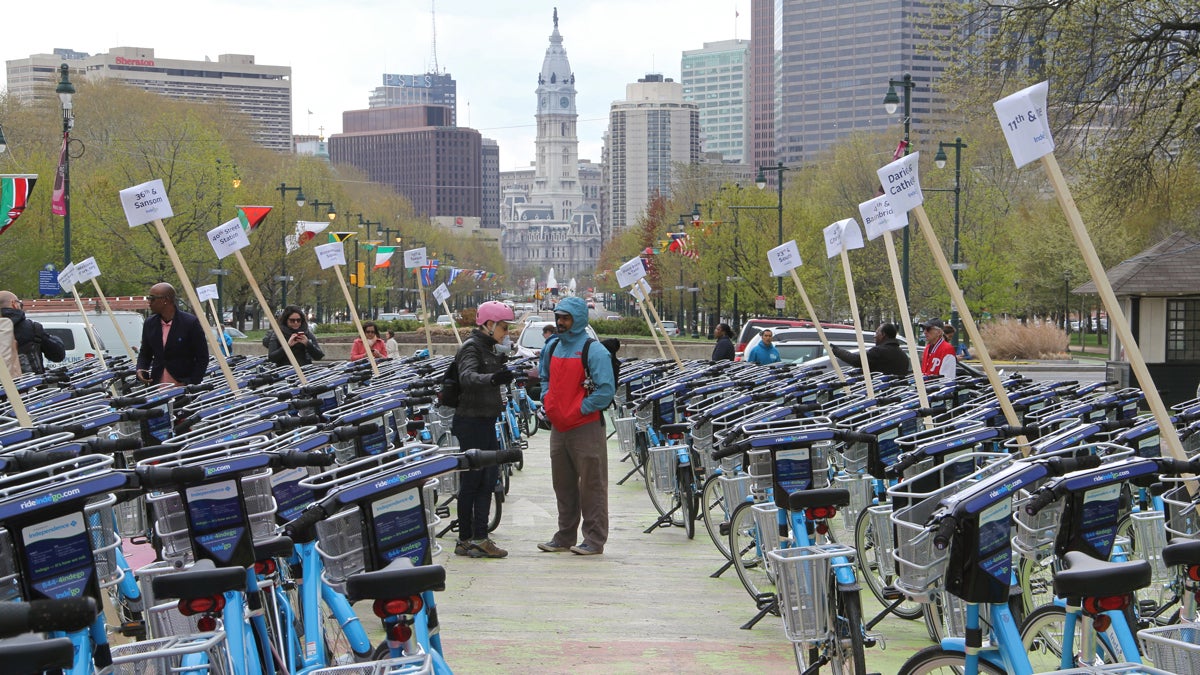How smaller cities should think differently about bike share

Philadelphia launched its bike share program, Indego, with 300 bicycles at 60 stations around the city. Mayor Nutter said the city plans to increase to 2,000 bikes at 180 docking stations. (Emma Lee/WHYY)
For smaller Pa. cities like Harrisburg and Lancaster, there are some unique challenges to consider when planning and implementing bike sharing systems.
Last week, Philadelphia launched its new bike share program, Indego. Next month Pittsburgh plans on rolling out its new bike share system, Healthy Ride. And recently, Bike Share Harrisburg announced its proposal to bring 10 bike kiosks and about 100 bikes to the capitol city.
Although there has been recent buzz and excitement surrounding new bike share systems, Pennsylvania cities are admittedly late to the trend.
Denver, Minneapolis, and Washington D.C. kicked off their bike share programs in 2010, followed by Boston in 2011, and there are more than 80 municipal and university bike share systems nationwide, according to the Pedestrian and Bicycle Information Center.
But for smaller Pa. cities like Harrisburg and Lancaster, there are some unique challenges to consider when planning and implementing bike share systems.
Alison Cohen, president and CEO of Bicycle Transit Systems, the company that just launched and operates Philadelphia’s bike share, says that any city can buy some bikes and put in some docking stations, but the real question is actually creating a system that people are going to use.
In smaller cities, Cohen says bike-shares work well in downtowns or town centers, but once you leave denser areas, challenges arise.
“Most bike share systems work because you put a station or a bicycle within a five minute walk of where people want to be,” she says. “Once you get into less dense areas, people don’t want to walk 15 minutes to get to a bike, to bike 20 minutes, and then walk another 15 minutes to get where they need to go.”
Cohen added that for smaller cities, it’s unlikely that a bike share system is going to replace the need to own a car. Rather, the bike share system can be used as an alternative transportation option for people who might have used their cars during their lunch break or for short trips once they’re already near a town center.
Bike sharing can also be an opportunity for residents and visitors to experience a city in a new way.
One smaller city without a strong bike culture often cited as an example for other cities to learn from is Chattanooga, Tennessee.
Three years into Bike Chattanooga, Ben Taylor, assistant transportation engineer for the city says their biggest hurdle is still getting people to take their first ride.
“People will walk by the stations and think that it’s for somebody else,” Taylor said.
Taylor said the system has been great for tourism and for visitors to explore downtown Chattanooga. For residents, it’s most useful for those who have a station close to home and close to work—so placement of the stations is key. Its next step is to expand into more neighborhoods, with the goal of replacing car trips downtown with more bike trips.
Another option for smaller cities like Harrisburg, Lancaster, York, and Reading, said Cohen, is the possibility of a regional bike sharing system.
“People are not likely to bike from one city to another city in Central Pa., but could you use the same bike key if you live in one city and work in another?”
An example of a regional bike sharing system, Cohen said, is the Research Triangle region in North Carolina, where people live, work, and play in three cities—Raleigh, Durham, and Chapel Hill. So, it makes sense to be able to use the same bike key and membership for all three cities, said Cohen.
To create a system that is useful to everyone, whether it’s a regional area, small city or a major metro, Cohen says, it’s important to look at bike sharing like any other transit system—with a lot of planning and a model that can be supported.
WHYY is your source for fact-based, in-depth journalism and information. As a nonprofit organization, we rely on financial support from readers like you. Please give today.



